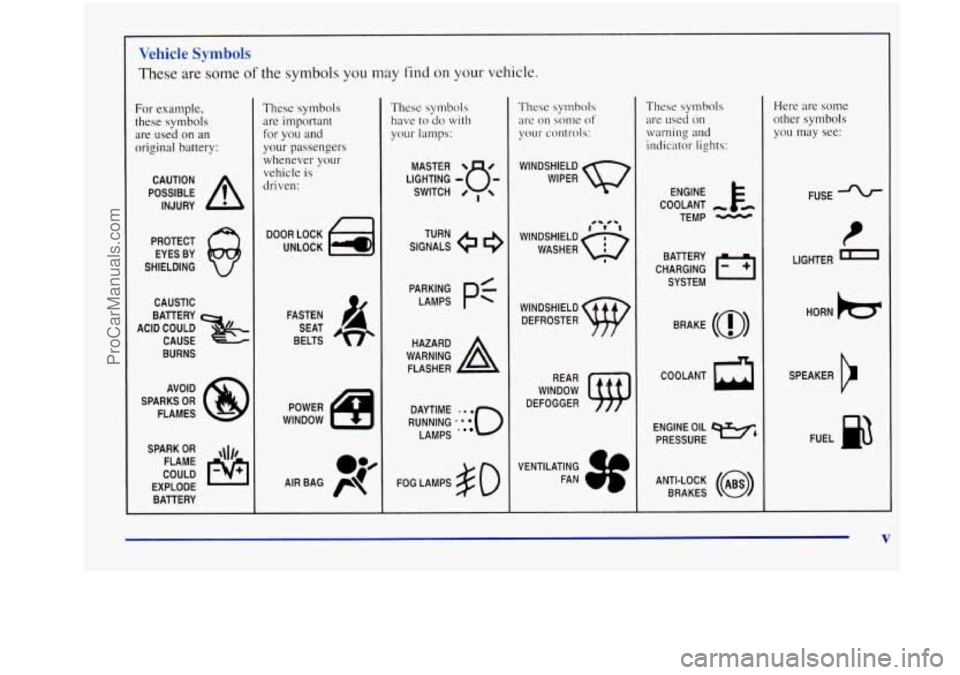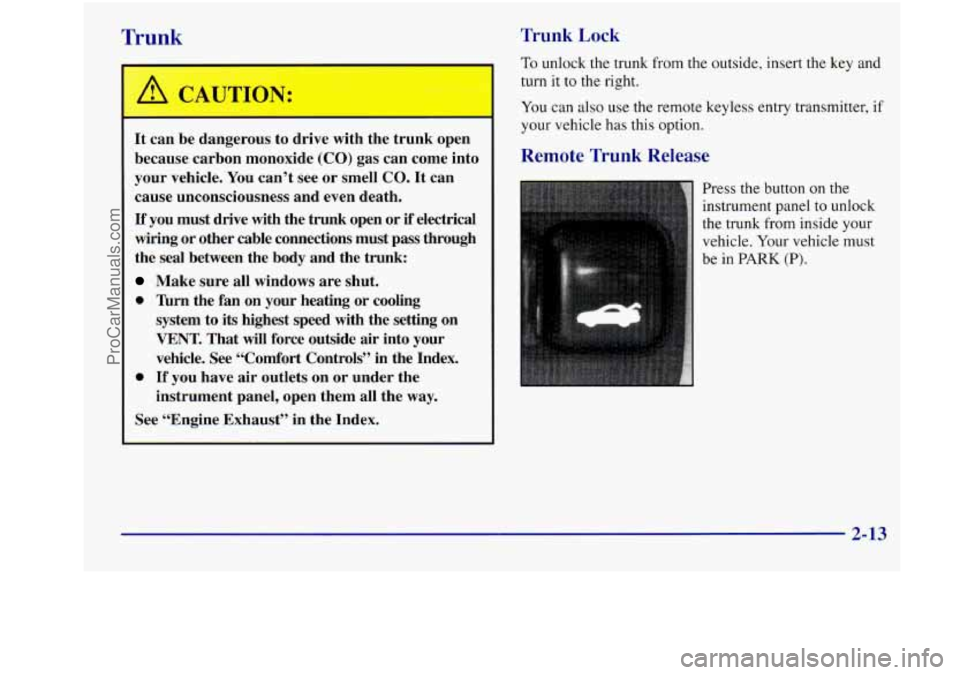window OLDSMOBILE INTRIGUE 1998 Owners Manual
[x] Cancel search | Manufacturer: OLDSMOBILE, Model Year: 1998, Model line: INTRIGUE, Model: OLDSMOBILE INTRIGUE 1998Pages: 340, PDF Size: 17.93 MB
Page 7 of 340

These are some of the symbols you may find on your vehicle.
For example,
these symbols
are used on an
original battery:
POSSIBLE A
CAUTION
INJURY
PROTECT EYES BY
SHIELDING
CAUSTIC
BURNS
SPARK
OR ,\I/,
COULD FLAME
EXPLODE BATTERY
These symbols are important
for you and
your passengers
whenever your
vehicle is
driven:
DOOR LOCK
UNLOCK
a
FASTEN SEAT
BELTS
These symbols have
to do with
your lamps:
SIGNALS e
TURN
RUNNING
*':**o
DAYTIME LAMPS
FOG LAMPS $0
These symbols
;II% on some of
your controls:
WINDSHIELD
WIPER
WINDSHIELD DEFROSTER
WINDOW
DEFOGGER
VENTILATING FAN
These symbols are used on
warning and
indicator lights:
COOLANT -
TEMP -
CHARGING I-1
BATTERY
SYSTEM
BRAKE
(0)
ENGINE OIL e,
PRESSURE
ANTI-LOCK
(@)
BRAKES
Here are some
other symbols
you may see:
FUSE
LIGHTER
n
HORN )b(
SPEAKER
b
FUEL m
V
ProCarManuals.com
Page 27 of 340

The best way to protect the fetus is to protect the
mother. When a safety belt is worn properly, it’s more
likely that the fetus won’t be hurt in
a crash. For
pregnant women, as for anyone, the key to making
safety belts effective is wearing them properly.
Right Front Passenger Position
To learn how to wear the right front passenger’s safety
belt properly, see “Driver Position’’ earlier in this section.
The right front passenger’s safety belt works the same
way as the driver’s safety belt
-- except for one thing. If
you ever pull the shoulder portion of the belt out all the
way, you will engage the child restraint locking feature.
If this happens, just let the belt go back all the way and
start again.
Supplemental Restraint System (SRS)
This part explains the Supplemental Restraint System
(SRS) or air bag system.
Your vehicle has two air bags
-- one air bag for the
driver
and another air bag for the right front passenger.
The air bags in your vehicle may be “Next Generation”
reduced-force frontal air bags.
If your vehicle has a label on the driver’s side door
window, then your vehicle has reduced-force frontal air
bags.
If your vehicle doesn’t have a label, then the air
bags
in your vehicle aren’t reduced-force.
Reduced-force frontal air bags are designed to help
reduce the risk of injury from the force
of an inflating
air bag. But even these air bags must inflate very
quickly if they are to
do their job and comply with
federal regulations.
1-19
-
ProCarManuals.com
Page 32 of 340

How does an air bag restrain?
In moderate to severe frontal or near-frontal collisions,
even belted occupants can contact the steering wheel
or the instrument panel. Air bags supplement the
protection provided by safety belts. Air bags distribute
the force of the impact more evenly over the occupant’s
upper body, stopping the occupant more gradually.
But air bags would not help you in many types of
collisions, including rollovers, rear impacts and side
impacts, primarily because an occupant’s motion is
not toward those air bags. Air bags should never be
regarded as anything more than a supplement to safety
belts, and then only in moderate to severe frontal or
near-frontal collisions.
What will you see after an air bag inflates?
After an air bag inflates, it quickly deflates, so
quickly that some people may not even realize the
air bag inflated. Some components of the air bag
module
-- the steering wheel hub for the driver’s
air bag, or the instrument panel for the right front
passenger’s bag
-- will be hot for a short time. The
parts of the bag that come into contact with you may be
warm, but not too hot to touch. There will be some
smoke and dust coming from vents in the deflated air
bags. Air bag inflation doesn’t prevent the driver from seeing or from being able to steer
the vehicle, nor does
it stop people from leaving the vehicle.
When an air bag inflates, there is dust in the air.
This dust could cause breathing problems for
people with a history
of asthma or other
breathing trouble.
To avoid this, everyone in the
vehicle should get out as soon
as it is safe to do so.
If you have breathing problems but can’t get out
of the vehicle after an air bag inflates, then get
fresh air by opening a window or door.
1-24
ProCarManuals.com
Page 35 of 340

Rear Seat Passengers
It's very important for rear seat passengers to buckle up!
Accident statistics show that unbelted people in the rear
seat are hurt more often in crashes than those who
are
wearing safety belts.
Rear passengers who aren't safety belted can be thrown
out
of the vehicle in a crash. And they can strike others
in the vehicle who are wearing safety belts.
Rear Seat Outside Passenger Positions
Lap-Shoulder Belt
The positions next to the windows have lap-shoulder
belts. Here's how to wear one properly.
1. Pick up the latch plate and pull the belt across you.
Don't let it get twisted.
The shoulder belt may lock if you pull the belt across
you very quickly.
If this happens, let the belt go back
slightly to unlock
it. Then pull the belt across you
more slowly.
1-27
ProCarManuals.com
Page 48 of 340

A booster seat (F, G) is designed for children who
are about
40 to 60 lbs. (1 8 to 27 kg) and about
four
to eight years of age. It’s designed to improve
the fit of the vehicle’s safety belt system. Booster
seats with shields use lap-only belts; however,
booster seats without shields use lap-shoulder
belts. Booster seats can also help a child
to see
out the window.
1-40
ProCarManuals.com
Page 56 of 340

6. To tighten the belt, feed the shoulder belt back into the
retractor while you push down on the child restraint. You may fmd it helpful to use your knee to push down
on the child restraint
as you tighten the belt.
7. Push and pull the child restraint in different
directions to
be sure it is secure.
To remove the child restraint, just unbuckle the vehicle’s
safety belt and let it go back all the way. The safety belt
will move freely again and be ready to work for an adult
or larger child passenger.
1-48
Larger Children
Children who have outgrown child restraints should
wear the vehicle’s safety belts.
If
you have the choice, a child should sit next to a
window
so the child can wear a lap-shoulder belt and
get the additional restraint a shoulder belt can provide.
ProCarManuals.com
Page 61 of 340

Section 2 Features and Controls
Here you can learn about the many standard and optional features on your vehicle, and information on starting,
shifting and braking. Also explained are the instrument panel and the warning systems that tell you if everything is
working properly
-- and what to do if you have a problem.
2-2
2-4
2-8
2-
13
2- 14
2- 14
2- 15
2-
16
2- 17
2-18
2-20
2-24
2-25
2-27 Keys
Door Locks
Keyless Entry System
Trunk
Theft
Passlock@
New Vehicle “Break-In”
Ignition Positions Starting Your Engine
Engine Coolant Heater (If Equipped)
Automatic Transaxle Operation
Parking Brake
Shifting Into PARK
(P)
Shifting Out of PARK (P) 2-27
2-28
2-28
2- 29
2-30
2-3
1
2-38
2-40
2-43
2-46
2-49
2-50 2-55 Parking Over Things That Burn
Engine Exhaust
Running Your Engine While You’re Parked
Windows Tilt Steering Wheel
Turn Signal/Multifunction Lever
Exterior Lamps
Interior
Lamps
Mirrors
Storage Compartments
Power Sunroof (If Equipped)
Instrument Panel
-- Your Information System
Warning Lights, Gages and Indicators
2-1
ProCarManuals.com
Page 62 of 340

Keys
A CAUTION:
I
Leaving young children in a vehicle with the
ignition key is dangerous for many reasons.
A child or others could be badly injured or
even killed.
They could operate power windows or other
controls or even make the vehicle move. Don't
leave the keys in a vehicle with young children.
2-2
ProCarManuals.com
Page 73 of 340

Trunk Trunk Lock
It can be dangerous to drive with the trunk open
because carbon monoxide (CO) gas can come into
cause unconsciousness and even death.
If you must drive with the trunk open or if electrical
wiring or other cable connections must pass through
the seal between the body and the trunk:
Make sure all windows are shut.
0 lbrn the fan on your heating or cooling
1 your vehicle. You can’t see or smell CO. It can
system to
its highest speed with the setting on
VENT. That will force outside air into your
vehicle. See
“Comfort Controls” in the Index.
instrument panel, open them all the
way.
0 If you have air outlets on or under the
See “Engine Exhaust” in the Index.
To unlock the trunk from the outside, insert the key and
turn it to the right.
You can also use the remote keyless entry transmitter, if
your vehicle has
this option.
Remote Trunk Release
Press the button on the
instrument panel to unlock
the trunk
from inside your
vehicle. Your vehicle must
2-13
ProCarManuals.com
Page 74 of 340

Theft Parking Lots
If you park in a lot where someone will be watching
your vehicle, it’s best to lock it up and take your keys.
But what if you have to leave your ignition key?
0 If possible, park in a busy, well lit area.
Vehicle theft
is big business, especially in some cities.
Although your vehicle has a number of theft-deterrent
features, we know that nothing we put on
it can make it
impossible to
steal. However, there are ways you can help.
Key in the Ignition
If you leave your vehicle with the keys inside, it’s an
easy target for joy riders or professional thieves
-- so
don’t do it.
When you park your vehicle and open the driver’s door,
you’ll hear a chime reminding
you to remove your key
from the ignition and take it with you. Always do this.
Your ignition and transaxle will be locked. And
remember
to lock the doors.
Parking at Night
Park in a lighted spot, close all windows and lock your
vehicle. Remember to keep your valuables out of sight.
Put them in a storage area, or take them with
you.
Put your valuables in a storage area, like your trunk or
glove box. Be sure to close and lock the storage area.
Close all windows.
0 Lock the glove box.
Lock all the doors except the driver’s.
0 Then take the door key and remote keyless entry
transmitter with you.
Passlock@
Your vehicle is equipped with the Passlock
theft-deterrent system.
Passlock is a passive theft-deterrent system. The system
is armed once the key is removed from the ignition.
Passlock enables fuel if the ignition lock cylinder is
turned with a valid key. If a correct key
is not used, fuel
is disabled.
2-14
ProCarManuals.com